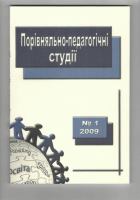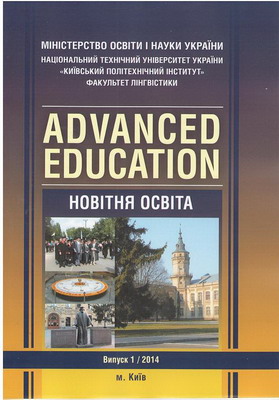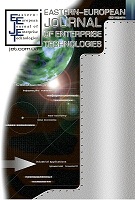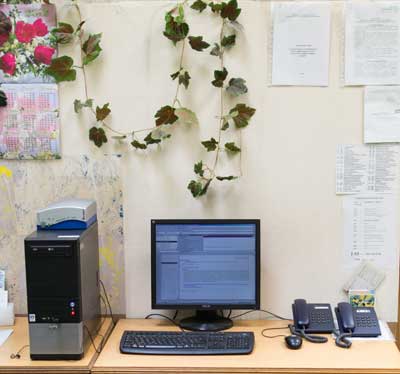
Бази даних
Наукова періодика України - результати пошуку
 |
Для швидкої роботи та реалізації всіх функціональних можливостей пошукової системи використовуйте браузер "Mozilla Firefox" |
|
|
Повнотекстовий пошук
| Знайдено в інших БД: | Реферативна база даних (1) |
Список видань за алфавітом назв: Авторський покажчик Покажчик назв публікацій  |
Пошуковий запит: (<.>A=Panchenko I$<.>) | |||
|
Загальна кількість знайдених документів : 5 Представлено документи з 1 до 5 |
|||
| 1. | 
Panchenko I. Evidence-based methodology on studying students' leadership skills [Електронний ресурс] / I. Panchenko // Studies in comparative education. - 2017. - № 1. - С. 16-25. - Режим доступу: http://nbuv.gov.ua/UJRN/Ppstud_2017_1_4 | ||
| 2. | 
Panchenko I. Leadership of erasmus mundus phd students in multicultural societies: defining and building a competence [Електронний ресурс] / I. Panchenko // Studies in comparative education. - 2018. - № 2. - С. 55-71. - Режим доступу: http://nbuv.gov.ua/UJRN/Ppstud_2018_2_8 | ||
| 3. | 
Zabolotna O. Teaching Ukrainian as a non-native language to national minorities in Ukraine: challenges for evidence-based educational policies [Електронний ресурс] / O. Zabolotna, S. Shchudlo, T. Medina, I. Panchenko, D. Kozlov // Advanced education. - 2019. - № 11. - С. 60-67. - Режим доступу: http://nbuv.gov.ua/UJRN/novocv_2019_11_10 | ||
| 4. | 
Mahdi Q. A. Development of a method of structural-parametric assessment of the object state [Електронний ресурс] / Q. A. Mahdi, R. Zhyvotovskyi, S. Kravchenko, I. Borysov, O. Orlov, I. Panchenko, Y. Zhyvylo, A. Kupchyn, D. Koltovskov, S. Boholii // Eastern-european journal of enterprise technologies. - 2021. - № 5(4). - С. 34-44. - Режим доступу: http://nbuv.gov.ua/UJRN/Vejpte_2021_5(4)__7 A method of structural and parametric assessment of the object state has been developed. The essence of the method is to provide an analysis of the current state of the object under analysis. The key difference of the developed method is the use of advanced procedures for processing undefined initial data, selection, crossover, mutation, formation of the initial population, advanced procedure for training artificial neural networks and rounding coordinates. The use of the method of structural-parametric assessment of the object state allows increasing the efficiency of object state assessment. An objective and complete analysis is achieved using an advanced algorithm of evolution strategies. The essence of the training procedure is the training of synaptic weights of the artificial neural network, the type and parameters of the membership function, the architecture of individual elements and the architecture of the artificial neural network as a whole. An example of using the proposed method in assessing the operational situation of the troops (forces) grouping is given. The developed method is 30 - 35 % more efficient in terms of the fitness of the obtained solution compared to the conventional algorithm of evolution strategies. Also, the proposed method is 20 - 25 % better than the modified algorithms of evolution strategies due to the use of additional improved procedures according to the criterion of fitness of the obtained solution. The proposed method can be used in decision support systems of automated control systems (artillery units, special-purpose geographic information systems). It can also be used in DSS for aviation and air defense ACS, DSS for logistics ACS of the Armed Forces of Ukraine.We developed a method of training artificial neural networks for intelligent decision support systems. A distinctive feature of the proposed method consists in training not only the synaptic weights of an artificial neural network, but also the type and parameters of the membership function. In case of impossibility to ensure a given quality of functioning of artificial neural networks by training the parameters of an artificial neural network, the architecture of artificial neural networks is trained. The choice of architecture, type and parameters of the membership function is based on the computing resources of the device and taking into account the type and amount of information coming to the input of the artificial neural network. Another distinctive feature of the developed method is that no preliminary calculation data are required to calculate the input data. The development of the proposed method is due to the need for training artificial neural networks for intelligent decision support systems, in order to process more information, while making unambiguous decisions. According to the results of the study, this training method provides on average 10 - 18 % higher efficiency of training artificial neural networks and does not accumulate training errors. This method will allow training artificial neural networks by training the parameters and architecture, determining effective measures to improve the efficiency of artificial neural networks. This method will allow reducing the use of computing resources of decision support systems, developing measures to improve the efficiency of training artificial neural networks, increasing the efficiency of information processing in artificial neural networks. | ||
| 5. | 
Zabolotna O. Teaching English vocabulary online: is the screen a barrier? [Електронний ресурс] / O. Zabolotna, L. Zagoruiko, I. Panchenko, Y. Plotnikov // Advanced education. - 2021. - № 17. - С. 57-64. - Режим доступу: http://nbuv.gov.ua/UJRN/novocv_2021_17_9 | ||
 |
| Відділ наукової організації електронних інформаційних ресурсів |
 Пам`ятка користувача Пам`ятка користувача |